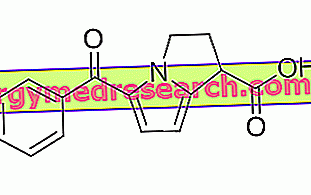COUMADIN ® is a drug based on sodium warfarin.
THERAPEUTIC GROUP: Antithrombotics.
IndicationsAction mechanismStudies and clinical effectiveness Usage and dosage instructionsWarnings Pregnancy and lactationInteractionsContraindicationsUndesirable effects
Indications COUMADIN ® Warfarin
COUMADIN ® is indicated in the treatment and prevention of diseases on a thrombotic basis, such as pulmonary embolism, arterial thromboembolism associated with chronic atrial fibrillation or valve prosthesis, deep vein thrombosis, infarction and ischemic events.
COUMADIN ® is also used successfully in the prevention of recurrences on an ischemic basis.
Mechanism of action COUMADIN ® Warfarin
Warfarin, taken orally by COUMADIN ®, is rapidly and completely absorbed in the intestine, then bound in the circulatory stream to plasma proteins, especially albumin.
The maximum plasma concentrations can be reached in a very wide interval of time, up to 9 hours from oral intake, while the therapeutic action is maximized within 36-72 hours, persisting for several days.
The metabolism of the two enantiomers, present in the racemic mixture in the drug, is supported by different hepatic cytochromial enzymes, susceptible both to the concomitant intake of other active ingredients, and to the presence of polymorphic variants such as not to allow a univocal characterization of the pharmacokinetic properties of this principle active.
In any case, after hepatic metabolism, inactive warfarin metabolites are eliminated mainly through the urine.
The anticoagulant action of warfarin is due to the antagonistic action against vitamin K. In order to activate the coagulation cascade, it is in fact known the need for post-translational modifications, in this case gamma carboxylations, against plasma soluble factors; this crucial event is guaranteed by an enzyme that uses reduced vitamin K as a cofactor.
Warfarin and coumarin derivatives are able to block the enzyme reductase involved in the regeneration of the active form of vitamin K, preventing the initialization and progression of the coagulation reaction. However, in order for this process to take on clinically relevant characteristics, it is appropriate that the bioavailability of vitamin K in an active form is reduced in favor of that in epoxid form, and that plasma concentrations of coagulation factors decrease. All these events require a time period that can range from 12 to 72 hours, when the therapeutic effect is generally maximum.
Studies carried out and clinical efficacy
WARFARIN IN THE ATRIAL FIBRILLATION
One of the most common side effects of atrial fibrillation is cerebral embolism, which often represents the leading cause of death in these patients. Warfarin-based drug treatment has guaranteed a reduction in the risk of stroke in patients with atrial fibrillation, around 60%, for decades now. Despite the great therapeutic efficacy, there are serious obstacles to the routine use of this drug, determined by the need for stringent control, frequent dosage adjustments and important side effects. These limits are pushing the pharmaceutical industry towards testing new products that can preserve the therapeutic effect of warfarin, making the therapy more manageable and less dangerous.
2. THE EFFECTS OF THE GENOTYPE ON THE EFFECTIVENESS OF WARFARIN THERAPY
Warfarin, commonly used in clinical practice as an anticoagulant, is metabolized by liver enzymes subject to numerous polymorphisms. Several experimental pharmacogenomic evidences point out that these enzymatic variants, very widespread in the population, can significantly vary the pharmacokinetic characteristics of the active ingredient, increasing the risk of side effects. These data suggest the need to insert a genetic test at the base of the dosage formulation.
3. AUTOMATIC TREATMENT WITH WARFARIN
Currently the active ingredient warfarin is one of the most used drugs in the prevention of thrombotic events. One of the most important limits of the therapy is the need for frequent checks, useful for verifying the patient's coagulation pattern to eventually adjust the dosage in order to reduce adverse events. To make the therapy easier to apply and make the patient responsible for the concept of health, new methods of self-monitoring have been widespread in the English population undergoing treatment. The use of these devices could guarantee a big step forward, streamlining most of the associated problems, for the diffusion of oral anticoagulant therapy.
Method of use and dosage
COUMADIN ® 5 mg warfarin sodium tablets : it is not possible to define a standard and effective dosage valid for all patients, since the formulation of the correct therapeutic plan must take into account various functional-hematological characteristics of the patient himself.
More precisely, given the therapeutic uselessness of high doses of warfarin, and given the potential side effects, it is appropriate to establish the dosage based on the prothrombin time expressed according to the international normalized ratio. This arrangement makes it possible to reconstitute therapeutic plans based on the patient's physiological and pathological needs and characteristics.
In a similar way, the dosage of COUMADIN ® in the maintenance phase as well as the duration of the therapeutic intervention should also be established. Particular precautions should be taken for elderly patients, where the initial dosage is generally lower than the recommended dosage.
IN ANY CASE, BEFORE TAKING COUMADIN ® Warfarin, THE REQUIREMENT AND CHECK OF YOUR DOCTOR IS NECESSARY.
Warnings COUMADIN ® Warfarin
It is of fundamental importance to establish the correct dosage of COUMADIN ® based on the haematological and coagulative characteristics of the patient, in order to avoid unpleasant side reactions such as bleeding, including internal bleeding, and necrosis with gangrene of various tissues, for which it may also be necessary surgical removal.
For this reason it is of fundamental importance to periodically monitor the patient's coagulation and, if necessary, adjust the therapy, taking into account that the concomitant administration of other drugs, such as heparin, could alter the observed picture.
COUMADIN ® could lead to an increased risk of cholesterine microembolization, evidenced by symptoms such as: purple finger syndrome, bruises, skin rash, gangrene, intense and sudden pain along the lower limbs; foot ulcers; myalgia, gangrene; abdominal pain, pain in the back or side; hematuria; kidney failure; hypertension; cerebral ischemia; spinal cord infarction; pancreatitis; symptoms that simulate polyarteritis or associated with embolic occlusion.
In all these cases it is appropriate to provide for the rapid interruption of the pharmacological treatment.
Particular attention should also be paid, in the case of elderly patients with mild or moderate renal and hepatic insufficiency, to trauma, hypertension or conditions predisposing to the risk of bleeding.
There are also particular hereditary diseases that are difficult to diagnose, such as deficiencies of protein C, which could amplify the biological effects of warfarin, significantly increasing the incidence and severity of side effects.
The presence of side effects such as dizziness, headache, bleeding etc. it could alter the patient's normal perceptual abilities, making it dangerous to use machinery and drive vehicles.
It would also be advisable to remind rescuers, in the event of various types of accidents, that they are subjected to anticoagulant therapy.
PREGNANCY AND BREASTFEEDING
COUMADIN ® is strongly contraindicated in pregnancy, as it has been described embryopathies, fetal malformations, mental retardation, growth deficiency, spontaneous abortion and fetal death in case of warfarin administration especially in the first trimester of pregnancy.
The active ingredient is also found in breast milk, therefore it is advisable to stop breast-feeding if therapy with this drug is necessary.
Interactions
In the case of COUMADIN ® in addition to highlighting all the direct interactions in which the active principle is involved, it would be appropriate to examine the conditions capable of determining an alteration of the prothrombin time, directing the dosage towards an incorrect formulation, responsible for potential and dangerous side effects.
Contraindications COUMADIN ® Warfarin
COUMADIN ® is contraindicated in case of hypersensitivity to one of its components, in patients at risk of bleeding (surgical interventions, active ulcers, trauma, blood dyscrasias, lumbar punctures ...) in elderly patients not adequately supported, in non-cooperative patients, in case of severe hypertension, diabetes and reduced liver function and during pregnancy and lactation.
Particular physio-pathological conditions of the patient (blood dyscrasias, high fever, diarrhea, liver diseases, nutritional deficiencies, cancer, steatorrhea, vascular diseases, heart failure) could lead to an increase in prothrombin time, while others (hyperlipidemia, hereditary coumarine resistance, nephrosis, hypothyroidism and edema) could lead to a decrease.
From a pharmacological point of view, the anticoagulant effect can be enhanced by: allopurinol, anabolic steroids, androgens, antiarrhythmic agents (amiodarone, quinidine), antibiotics, pheniramidol, clofibrate, disulfiram, ac. ethacrinic, glucagon, anti H2, metronidazole, sulfonamides, oral antidiabetics, thyroid hormones, sulfinpyrazone, chloral hydrate, ac. nalidixic and, in particular, from: aspirin, phenylbutazone, sulfinpyrazone and NSAIDs.
The anticoagulant action may instead be reduced by: aminoglutethimide, barbiturates, carbamazepine, colestyramine, griseo fulvina, oral contraceptives, cardioactive glucosides, corticosteroids, rifampicin, thiazide diuretics and preparations based on Hypericum perforatum.
Undesirable effects - Side effects
The side effects observed following the administration of COUMADIN ® are all related to the anticoagulant effect of warfarin.
In fact, a variegated symptomatology, characterized by widespread pain, muscle pain, respiratory difficulties, swelling, asthenia, hypotension, headache and paresthesia, could be indicative of ongoing hemorrhage.
The severity of the symptomatology is related to the extent of the bleeding, which in turn can be determined by predisposing factors, incorrect dosages and other variables of the case.
In addition to hemorrhage, necrosis has sometimes been associated with gangrene, microembolization, vasculitis, edema, increased transaminases, headaches, pain, dizziness, fever, chills and alopecia.
Note
COUMADIN ® is salable only under medical prescription.



